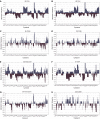Genomic copy number and expression patterns in testicular germ cell tumours
- PMID: 18059402
- PMCID: PMC2360290
- DOI: 10.1038/sj.bjc.6604079
Genomic copy number and expression patterns in testicular germ cell tumours
Abstract
Testicular germ cell tumours of adults and adolescents (TGCT) include seminomas (SE) and nonseminomas (NS), with spermatocytic seminomas (SSE) representing a distinct entity in older men. SE and NS have gain of 12p material in all cases, whereas SSE are associated with overrepresentation of chromosome 9. Here, we compare at the chromosomal level, copy number imbalances with global expression changes, identified by comparative expressed sequence hybridisation analyses, in seven SE, one combined tumour, seven NS and seven cell lines. Positive correlations were found consistent with copy number as a main driver of expression change, despite reported differences in methylation status in SE and NS. Analysis of chromosomal copy number and expression data could not distinguish between SE and NS, in-keeping with a similar genetic pathogenesis. However, increased expression from 4q22, 5q23.2 and 9p21 distinguished SSE from SE and NS and decreased copy number and expression from 2q36-q37 and 6q24 was a specific feature of NS-derived cell lines. Our analysis also highlights 19 regions with both copy number and expression imbalances in greater than 40% of cases. Mining available expression array data identified genes from these regions as candidates for involvement in TGCT development. Supplementary data is available at http://www.crukdmf.icr.ac.uk/array/array.html.
Figures


Similar articles
-
Role of gain of 12p in germ cell tumour development.APMIS. 2003 Jan;111(1):161-71; discussion 172-3. doi: 10.1034/j.1600-0463.2003.11101201.x. APMIS. 2003. PMID: 12752258 Review.
-
Chromosomal imbalances associated with carcinoma in situ and associated testicular germ cell tumours of adolescents and adults.Br J Cancer. 2001 Jul 20;85(2):213-20. doi: 10.1054/bjoc.2001.1889. Br J Cancer. 2001. PMID: 11461079 Free PMC article.
-
Novel genomic aberrations in testicular germ cell tumors by array-CGH, and associated gene expression changes.Cell Oncol. 2006;28(5-6):315-26. doi: 10.1155/2006/219786. Cell Oncol. 2006. PMID: 17167184 Free PMC article.
-
Pathogenesis of testicular germ cell tumours.Rev Reprod. 1999 May;4(2):90-100. doi: 10.1530/ror.0.0040090. Rev Reprod. 1999. PMID: 10357096 Review.
-
Overrepresentation of the short arm of chromosome 12 in seminoma and nonseminoma groups of testicular germ cell tumors.Cancer Genet Cytogenet. 2002 Apr 15;134(2):102-8. doi: 10.1016/s0165-4608(01)00619-7. Cancer Genet Cytogenet. 2002. PMID: 12034520
Cited by
-
Preclinical support for tumor protein D52 as a cancer vaccine antigen.Hum Vaccin Immunother. 2023 Dec 15;19(3):2273699. doi: 10.1080/21645515.2023.2273699. Epub 2023 Oct 30. Hum Vaccin Immunother. 2023. PMID: 37904517 Free PMC article. Review.
-
Specific genomic regions are differentially affected by copy number alterations across distinct cancer types, in aggregated cytogenetic data.PLoS One. 2012;7(8):e43689. doi: 10.1371/journal.pone.0043689. Epub 2012 Aug 24. PLoS One. 2012. PMID: 22937079 Free PMC article.
-
A Novel Quantitative Fluorescent Reporter Assay for RAG Targets and RAG Activity.Front Immunol. 2013 May 16;4:110. doi: 10.3389/fimmu.2013.00110. eCollection 2013. Front Immunol. 2013. PMID: 23720659 Free PMC article.
-
Genomic Instability of iPSCs: Challenges Towards Their Clinical Applications.Stem Cell Rev Rep. 2017 Feb;13(1):7-16. doi: 10.1007/s12015-016-9680-6. Stem Cell Rev Rep. 2017. PMID: 27592701 Free PMC article. Review.
-
Tumorigenic and Immunogenic Properties of Induced Pluripotent Stem Cells: a Promising Cancer Vaccine.Stem Cell Rev Rep. 2020 Dec;16(6):1049-1061. doi: 10.1007/s12015-020-10042-5. Epub 2020 Sep 16. Stem Cell Rev Rep. 2020. PMID: 32939647 Free PMC article. Review.
References
-
- Almstrup K, Ottesen AM, Sonne SB, Hoei-Hansen CE, Leffers H, Rajpert-De Meyts E, Skakkebaek NE (2005) Genomic and gene expression signature of the pre-invasive testicular carcinoma in situ. Cell Tissue Res 322: 159–165 - PubMed
-
- Balleine RL, Fejzo MS, Sathasivam P, Basset P, Clarke CL, Byrne JA (2000) The hD52 (TPD52) gene is a candidate target gene for events resulting in increased 8q21 copy number in human breast carcinoma. Genes Chromosomes Cancer 29: 48–57 - PubMed
-
- Byrne JA, Balleine RL, Schoenberg Fejzo M, Mercieca J, Chiew YE, Livnat Y, St Heaps L, Peters GB, Byth K, Karlan BY, Slamon DJ, Harnett P, Defazio A (2005) Tumor protein D52 (TPD52) is overexpressed and a gene amplification target in ovarian cancer. Int J Cancer 117: 1049–1054 - PubMed
-
- Goddard NC, McIntyre A, Summersgill B, Gilbert D, Kitazawa S, Shipley J (2007) KIT and RAS signalling pathways in testicular germ cell tumours: new data and a review of the literature. Int J Androl 30: 337–349 - PubMed
-
- Horwich A, Dearnaley DP, Nicholls J, Jay G, Mason M, Harland S, Peckham MJ, Hendry WF (1991) Effectiveness of carboplatin, etoposide, and bleomycin combination chemotherapy in good-prognosis metastatic testicular nonseminomatous germ cell tumors. J Clin Oncol 9: 62–69 - PubMed
Publication types
MeSH terms
LinkOut - more resources
Full Text Sources
Medical
Miscellaneous

